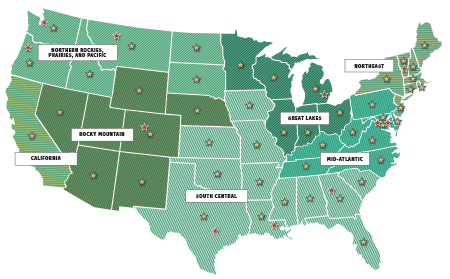
How do moose cross the road in Vermont?
That's a question the National Wildlife Federation's Northeast Regional Center is helping answer through the Critical Paths Project.
The National Wildlife Federation's Northeast Regional Center spearheads efforts to make safe pathways for wildlife in the pristine Worcester Mountains of Vermont, where some of the most deadly road crossings in America can be found. This Critical Paths Project is a model project that seeks to identify critical wildlife road crossings in the State of Vermont.
Working with the National Wildlife Federation's state affiliate, the Vermont Natural Resources Council, as well as the Vermont Department of Fish and Wildlife, Vermont Agency of Transportation, U.S. Forest Service, and Green Mountain and Finger Lakes National Forest, the National Wildlife Federation is studying the best places for corridors to help wildlife have room to roam.
To date the Critical Paths Project has identified 11 priority zones out of the 38 wildlife crossings along the spine of Vermont’s Green Mountains. Once the priority zones are identified, we then work with transportation officials to implement practical solutions that help reconnect habitat and protect wildlife.
The project uses a combination of cutting-edge computer modeling and good old fashion on-site field work to determine where bottlenecks and impermeable crossings exist that can impede the free movement of animals.
The National Wildlife Federation worked with a team of state biologists and conservation organizations to identify 11 critical "Priority Crossing Zones" along the spine of the Green Mountains that are essential to south-north wildlife movement.
The researchers assessed the physical features of the crossings and the natural features of adjacent landscapes. They also tracked and monitored wildlife movement patterns at each crossing over an extended period of time.
We're working with resource professionals, transportation experts, and local citizens to develop key strategies to make Vermont's roads safer and improve wildlife habitat connectivity. These strategies include:
As wildlife habitat comes under increasing pressure from road development and climate change, the work of the Critical Paths Project will help enhance migration pathways, strengthen wildlife populations, and reduce animal-vehicle collisions.
The Critical Paths Project was made possible with funding from the Wildlife Conservation Society, Vermont Department of Fish and Wildlife, and generous donations from individuals.
Take the Clean Earth Challenge and help make the planet a happier, healthier place.
Learn MoreA groundbreaking bipartisan bill aims to address the looming wildlife crisis before it's too late, while creating sorely needed jobs.
Read MoreMore than one-third of U.S. fish and wildlife species are at risk of extinction in the coming decades. We're on the ground in seven regions across the country, collaborating with 52 state and territory affiliates to reverse the crisis and ensure wildlife thrive.
